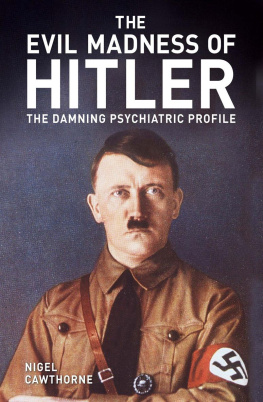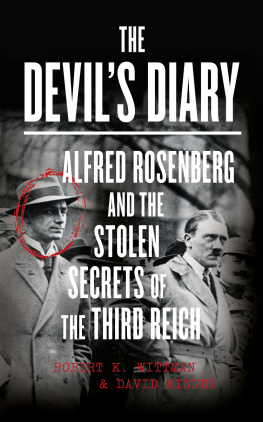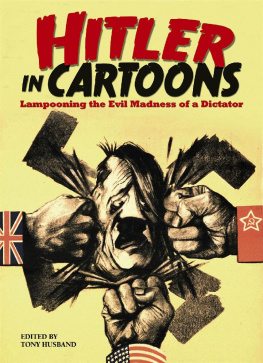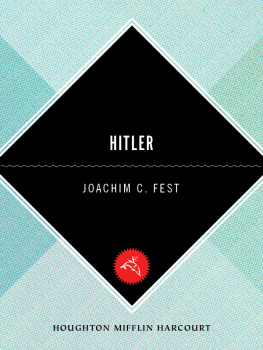
Published 2011 by Prometheus Books
Hitler: Beyond Evil and Tyranny. Copyright 2011 by R. H. S. Stolfi. All rights reserved. No part of this publication may be reproduced, stored in a retrieval system, or transmitted in any form or by any means, digital, electronic, mechanical, photocopying, recording, or otherwise, or conveyed via the Internet or a website without prior written permission of the publisher, except in the case of brief quotations embodied in critical articles and reviews.
Trademarks: In an effort to acknowledge trademarked names of products mentioned in this work, we have placed or after the product name in the first instance of its use in each chapter. Subsequent mentions of the name within a given chapter appear without the symbol.
Cover image Library of Congress
Cover design by Grace M. Conti-Zilsberger
Dedication painting, Honor the memory, Kathryn A. Stolfi, 1931-2010, She faced death Sans Peur,
She lived her life Sans Reproche, She was a heroine for the ages, by Sam Harris.
Inquiries should be addressed to
Prometheus Books
59 John Glenn Drive
Amherst, New York 14228-2119
VOICE: 716-691-0133 FAX: 716-691-0137
WWW.PROMETHEUSBOOKS.COM
15 14 13 12 11 5 4 3 2 1
Library of Congress Cataloging-in-Publication Data
Stolfi, R. H. S. (Russel H. S.), 1932
Hitler : beyond evil and tyranny / by R. H. S. Stolfi.
p. cm.
Includes bibliographical references and index.
ISBN 978-1-61614-474-6 (cloth : acid-free paper)
ISBN 978-1-61614-475-3 (ebook)
1. Hitler, Adolf, 1889-1945. 2. Hitler, Adolf, 1889-1945Psychology.
3. Personality and politicsGermanyCase studies. 4. Hitler, Adolf, 1889-1945Childhood and youth. 5. World War, 1914-1918Influence. 6. Heads of stateGermanyBiography. 7. GermanyHistory1933-1945. 8. GermanyHistory1918-1933. 9. National socialismHistory. I. Title.
DD247.H5S777 2011
943.086092dc23
[B]
2011023930
Every attempt has been made to trace accurate ownership of copyrighted material in this book. Errors and omissions will be corrected in subnsequent editions, provided that notification is sent to the publisher.

Honor the Memory
KATHRYN A. STOLFI
19312010
She faced death
Sans Peur
She lived her life
Sans Reproche
She was a heroine
for the ages

A fter half a century, no biographer or historian has put together an adequate interpretation of Adolf Hitler. Since Hitler can be acknowledged to have been the most significant figure of the twentieth century, how is such a situation possible? The answer may be that the hunt for Hitler has been for the wrong man in the wrong historical background. The hunt has been for a political animal in the guise of a wicked man who engaged in evil deeds. But the intellectual expeditions both great and small to capture Hitler have been seeking the wrong quarry in the wrong landscape. Hitler was neither a politician nor engaged in politics. And he cannot be considered to have believed that he was a wicked man perpetrating evil deeds. Hitler had the intense psychological makeup of a prophetically styled messiahone whose office he believed was to reveal a message of salvation to the Germans and to become the savior-hero himself. The landscape through which he moved was that of a Germany defeated in war and a European continent dominated by France. To think of Hitler as a German politician engaged in national politics would be like thinking of the quintessential Prophet Muhammad as an Arab politician engaged in similar political endeavors. Both must be comprehended as intense visionaries with their feet planted firmly several feet above the ground, in their own worlds of self-inspired revelation. Both achieved astonishing political results, but neither can be understood as a political ideologue.
Hitler brought more to the great messianic dance of the interwar period than the conventional wisdom has seen fit to accept. Underestimated by competitor and enemy contemporaneously and by biographers and historians since, he possessed traits unlike those of any other significant political figure of the era. Along with the intensity, seriousness, and earnestness that underpinned him as a self-professed messiah, he brought artistic qualities of brilliance in architecture, competence in painting, and the interest of a cognoscente in classical music. Based partly on this artistic makeup, he was characterized by extraordinary imagination and a lack of sense of proportion that would not allow him to embrace half-solutions to challenges. Thrown into this unlikely mix of traits and talents was a kind of lazy indolence that has confounded his biographers and baffled his contemporaries. In photographs that exist from World War I, he appears as dreamy visionary and fanatic adversary, pale and wrapped within an emaciated frame. Perhaps most interesting is that, in some of his photographs, his right eye seems to stare at something out of the picture and in another universe.
Writers throughout the world have put together a vast body of literature on Hitler and have used an even larger body of primary source material to buttress it. Against such a background, this book uses the following structure to extract a fresh interpretation of Hitler the person. First, because it is unlikely that any significant new primary source material will be found, this book does not search for it. Second, because another descriptive biography of Hitler would be an exercise in dullness, this book concentrates on interpretation. Overlying the literature on Hitler, there exists the great biographies that pull together most things on him that, because of their quality, comprehensiveness, and availability, dominate the worldview. The great biographers include, at least, Alan Bullock (1953), Werner Maser (1973), Joachim Fest (1974), John Toland (1976), and Ian Kershaw (1998), and their works hold the conventional wisdom on Hitler.book that follows will present a counterbalancing portrait of Hitler and a contrasting view of his times.
Virtually every literary piece written about Adolf Hitler in the more than half century since 1945 has been based on antipathy. In a seemingly boundless corpus of writing, every work from the mighty to the insignificant is fundamentally similar in its common revulsion for the man and his national movement. In the most recent great biography, Professor Ian Kershaw begins and ends with detestation. His work is skilled and often brilliant, but he fails to inform the reader of certain characteristics indispensable for true comprehension of the man, and he underestimates the importance of the postwar conditions inflicted by the Allies on Germany, which contributed to Hitler's rise. Bullock, Fest, and Kershaw ascribe criminal features to Hitler's foreign policy from 1933 through 1939, but they fail to correlate it realistically with the Allied imposition of the Versailles Treatythe ultimate manifestation of German defeat and Allied victory following World War I. The biographers then create, during the period 1939 through 1945, an interpretation of the course of World War II and Hitler's conduct of it that fails to correspond with the German leader's actual intentions and the realistic possibilities for German victory














